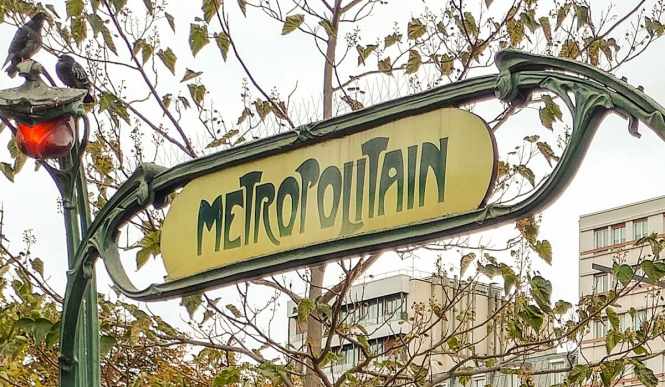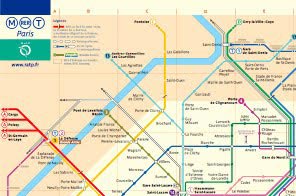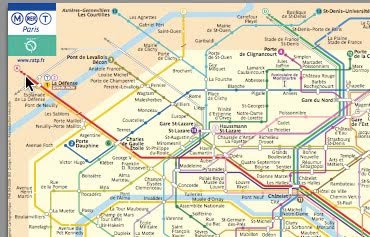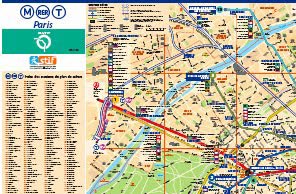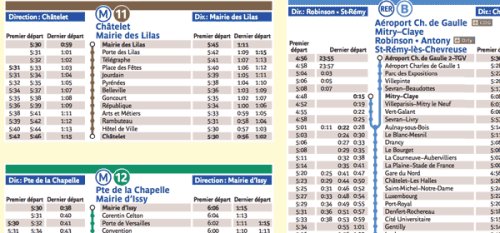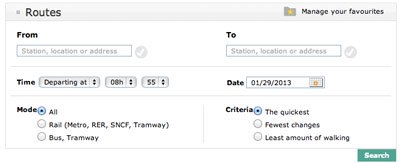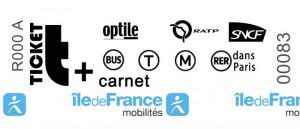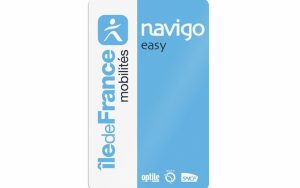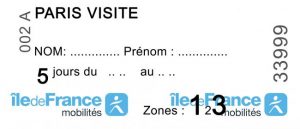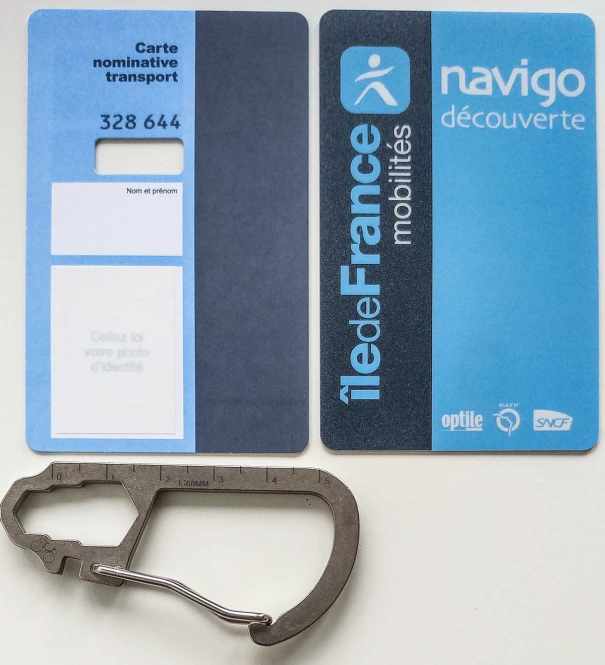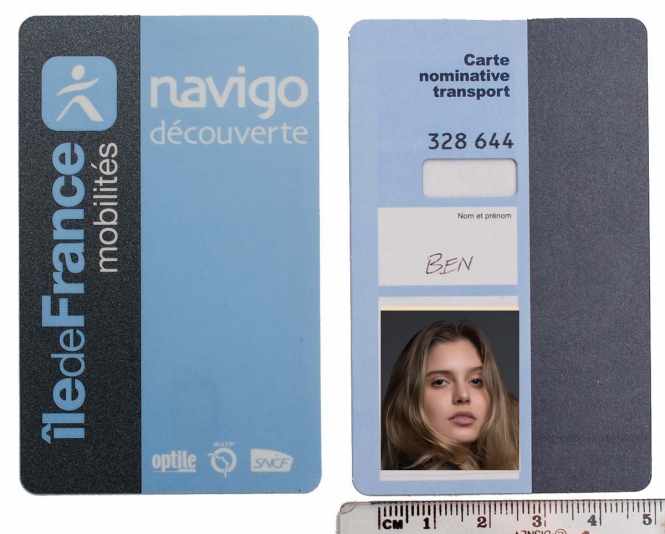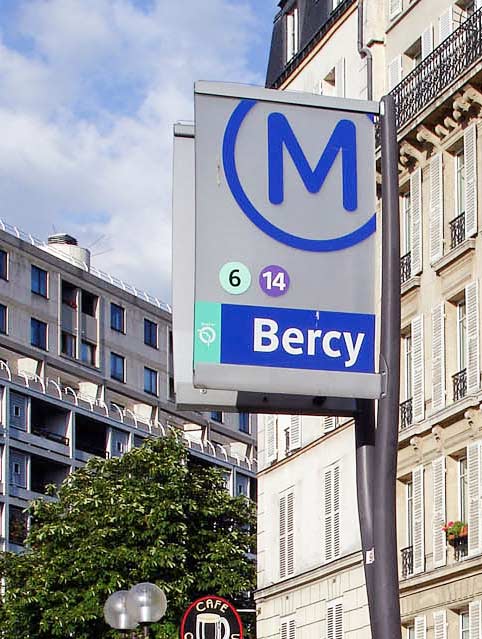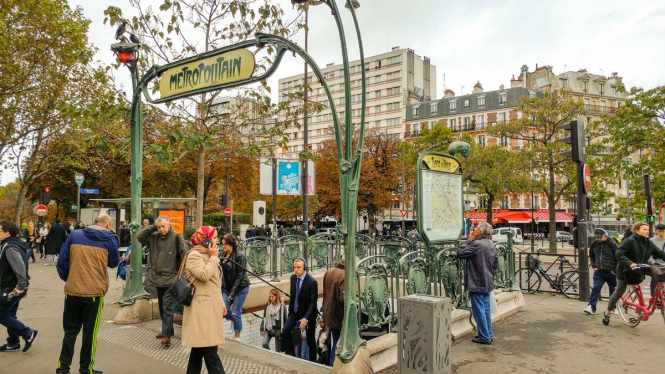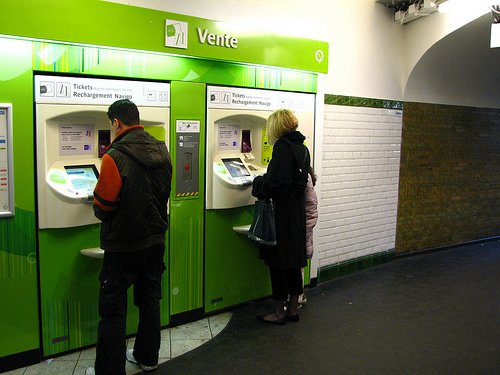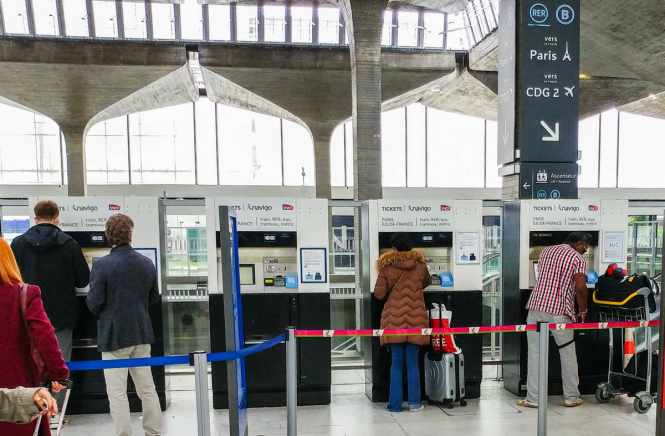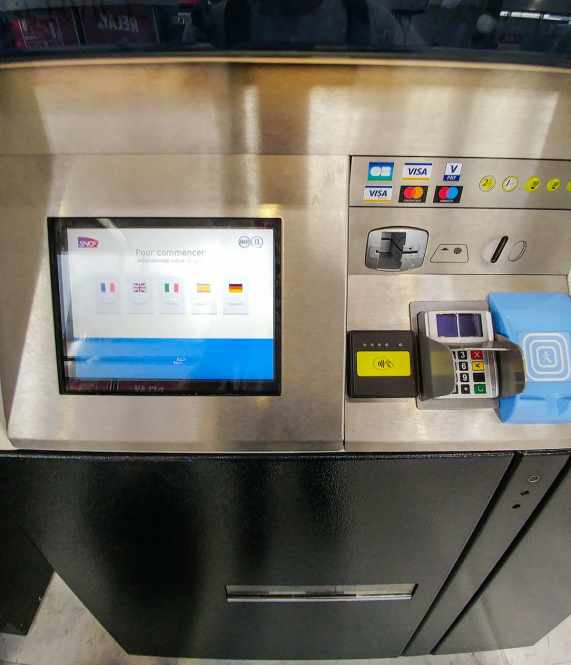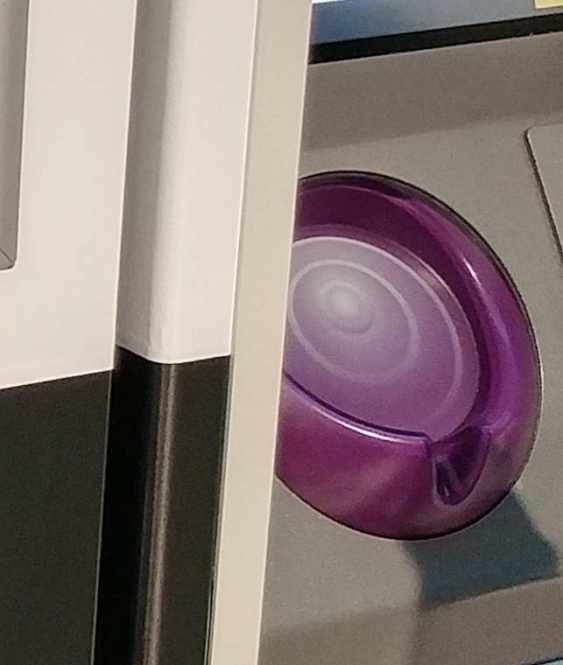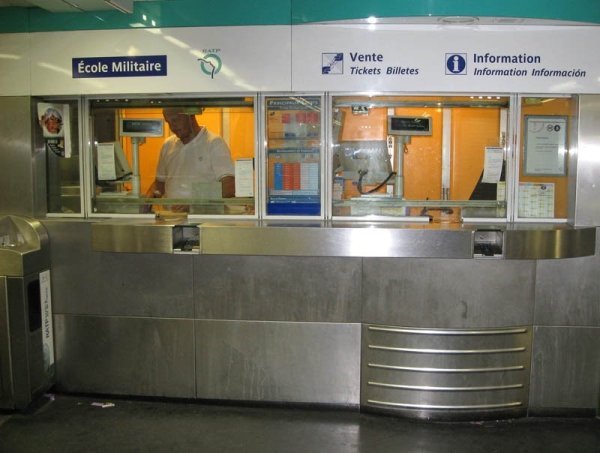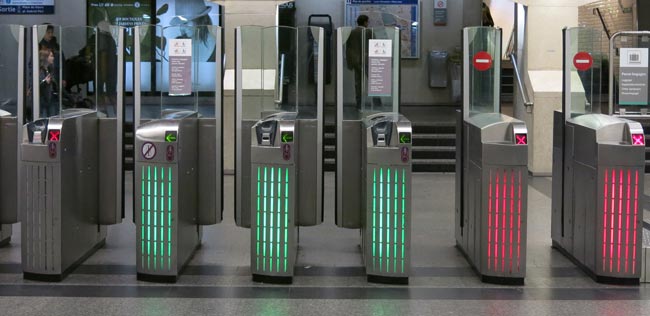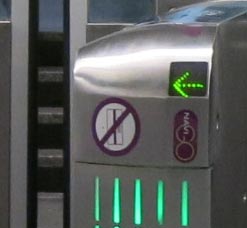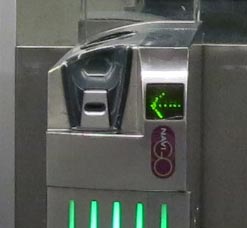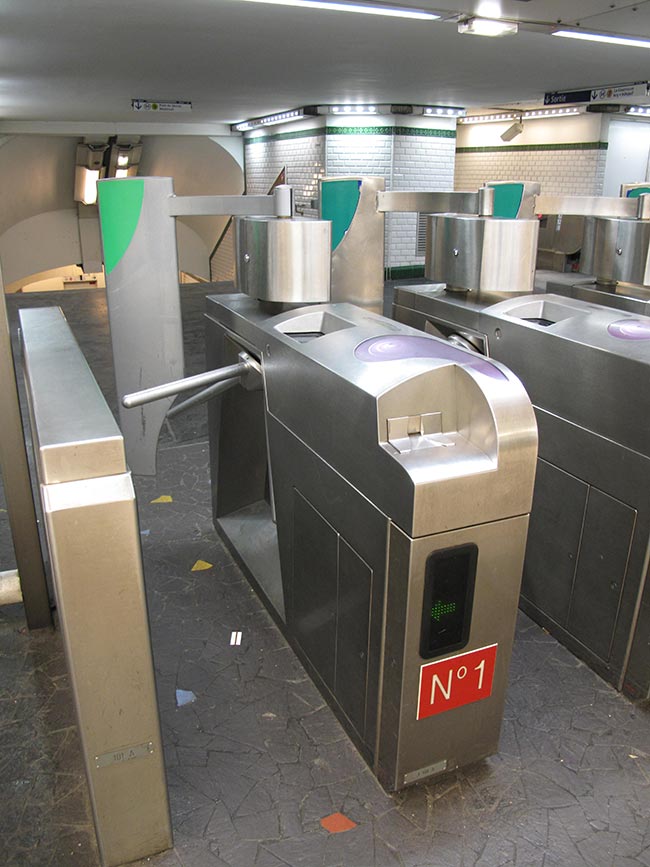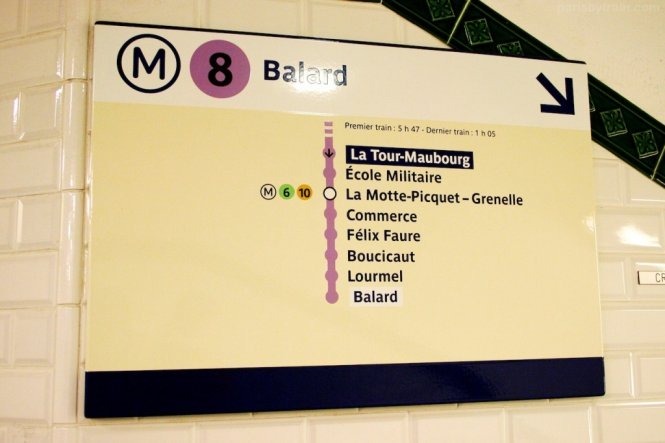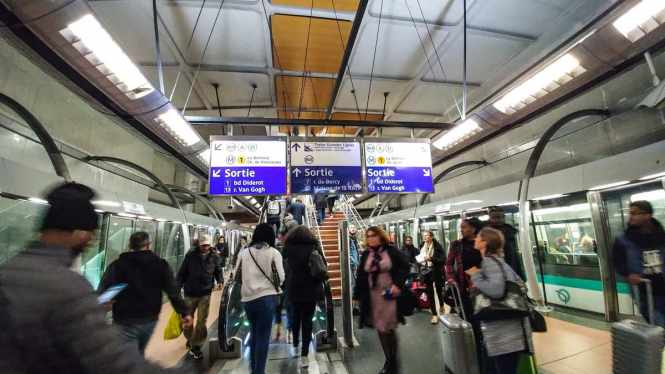Paris Metro subway – Maps, hours, tickets, passes & more
| Maps | Hours | Route Planner | Single Ticket |
| Day Pass | Multi-day Pass – Paris Visite | Week Pass – Navigo | Buying Tickets |
| Using Tickets | Riding Metro | Transfers | FAQ |
Below you’ll get Paris subway maps, hours, info on tickets, day passes & Navigo week passes, zones and learn how to use the Paris Metro in this first of a series of articles.
The Paris Subway / Paris Underground has over 300 Paris Metro stations on 16 lines covering the 10x10km area of central Paris. [1][2] Metro Paris lines are numbered from 1 to 14 with two “bis” or secondary lines 3b and 7b.
Paris Metro Maps
Here you can download three different Paris subway system maps to help you see all 16 Paris Metro lines and help you plan a route:
a basic Paris Metro map of lines with stations and interchanges (PDF – opens a new window)
a condensed small format Paris subway map
a Paris Metro map with city streets
Other Metro maps such as individual line maps can be downloaded directly from RATP.fr (in french). Note that there are no Paris Metro Zones for the Metro system. The Paris Metro is a single zone (even if some lines reach into zone 3). The zones visible on some older Paris Metro / RER maps are for RER trains which are subject to fare zones.
Paris Metro Hours
Paris Metro hours run from roughly 05:30 to 00:40 (5:30am – 12:40am) Sunday thru Thursday and 05:30 – 01:40 on Fridays, Saturdays and on days before a holiday. Paris Metro times between trains range from 2 minutes during rush hour up to 13 minutes during late night hours, holidays, and Sundays, depending on the Metro line and the Metro station. For example, Metro line 1 time between trains ranges from 2 minutes in morning/evening rush hours to every 5 minutes after midnight (Metro Line 1 is arguably the most central & popular Paris Metro line). The outer ends of Metro line 13 which splits into two separate lines in the outskirts, late night trains can run as slow as every 13 minutes as trains alternate between each end, effectively halving the frequency of train service. On average, expect 8-10 minutes between train times in the late evening and 2-4 minutes during rush hours.
Download a Paris Metro timetable showing first and last Paris Metro trains. Paris Metro hours change very little year-to-year and the RATP has stopped producing this full schedule in 2013 so this timetable of Metro Paris times is still useful to find Paris Metro opening hours and closing time. Times are approximate! This includes times of first train / last train of Paris RER A (Disneyland) and RER B (airport).
Route Planning
The RATP offers a route planner via their website which can use street addresses, station names or well known locations to create a travel itinerary for you, including necessary connections and total travel time. Route options under “Criteria” can be chosen for fewest connections, least amount of walking and quickest route (the default).
Tickets & Passes
The Paris tube has a wide variety of tickets available while I’ll describe in detail below: single ride tickets, books of 10 or 20, preloaded ticket cards, single day passes, multi-day passes, youth weekend passes, Monday to Sunday week passes, monthly passes and year passes.
Zones
Regarding fares for different zones: Paris Metro zones don’t exist! The entire Paris underground is one zone, unlike the Paris RER trains which have zones & different fares per zones traveled. Even though a few Paris Metro stations are actually outside of Paris fare zone 1, a single Paris Metro ticket is still valid for travel from inside zone 1 and ending at a Metro station outside of Paris zone 1.
Paris Metro Prices
Paris Metro prices as of Jan. 4, 2024 is 2.15€ for a one-way ride lasting up to 2 hours. (Note: your last transfer must be made within 1 hour 30 minutes. No further transfers are allowed after this time and you must complete your travel by the 2 hour mark.) There are a variety of Paris Metro tickets to buy and several Paris Metro Pass options shown in detail below.
Single Use Tickets
Basic Paris Metro tickets are known as “Ticket t+”. These tickets are valid for a single continuous journey of any length throughout the Paris Metro system, including changes to other Metro lines and RER interurban trains within Zone 1. These tickets are sold as single one-way fares or in books of 10. If you want a return ticket, you simply buy two Metro tickets. Paris Metro tickets have no expiry; You can use them at any time in the future.
Tickets can be purchased from ticket windows inside stations or through automated ticket vending machines accepting Euro coins and smart chip credit cards. The single ticket price as of Jan. 4, 2024 is 2.15€.
- Paris Metro / Bus / Tram tickets (Ticket t+): 4€
- RER train tickets (billet origine-destination): 6€ (regardless of distance)
- Navigo Week Pass: sales suspended, use Paris 2024 Pass
- Navigo Day Pass: sales suspended, use Paris 2024 Pass
Books of ten, called a “carnet” [kar-nay], are sold at a discount for 17.35€ when put on Navigo Easy or Paris transport mobile phone app or Apple Wallet (1.96€ / 1.74€ each, a little under 20% off the regular fare). Children from ages 4 to 9 years old (inclusive) can use reduced fare tickets, which are available only in books of 10, for 9.80€ per book of ten. Children 3 and under ride for free. Keep in mind that non-smart chip credit cards will not work at either the automated ticket machines nor at ticket windows, thus Euro cash or coin would be required.
Read more about Paris Metro Tickets and transfers allowed.
Ticket Cards
In 2019 Paris introduced a ticket card called Navigo Easy which holds digital single-use Paris Metro tickets. Holding up to 30 Paris Metro tickets, a Navigo Easy ticket card can be reloaded and used over a period of ten years. Navigo Easy also holds Navigo Day Passes and tickets for Roissybus and Orlybus.
Read more about Paris Metro ticket cards on the Navigo Easy page.
Day tickets
Day tickets (unlimited rides until midnight) are available in two formats: the Navigo Day Pass and the Paris Visite ticket.
The Navigo Day Pass is put onto a Navigo Découverte smart card (or compatible mobile phone Paris transit app) that allows tap entry to Paris Metro, RER, bus, and trams. The Paris Visite ticket is a paper-based ticket that is inserted into ticket readers aboard Paris buses, trams and at Paris Metro/RER station turnstiles and fare gates.
The basic difference between the two options:
The Navigo Day Pass by default has all 5-zones of coverage and must be scheduled for use either immediately or up to 6 days in the future and needs to be put onto a plastic smart card (5€ fee) or onto an iPhone / Android phone (no fee). Navigo Day Pass doesn’t cover the Orlyval train for Orly Airport (but does include the Orlybus bus and Tram 7 + Metro 7 and Metro 14 from Orly). See details on the Navigo Day pass.
The Paris Visite ticket includes the Orlyval Orly airport train, has some discounts to popular Paris tourist attractions and can be used immediately or anytime in the future without scheduling. But it costs more. See details on the Paris Visite pass.
Multi-Day Paris Metro Tickets
Multi-day tickets aimed at tourists and visitors are known as the Paris Visite, available in 3 zone and 5 zone versions, for 1, 2, 3 or 5 day lengths. For details on the Paris Visite, please see the Paris Visite pass page.
The Paris Visite is a multi-use paper ticket coupon (similar to a Paris Metro Ticket t+). Formerly (prior to 2014) the Paris Visite also came with a black folding card which required the printed name of the bearer and the ticket coupon requires the card number and date of use to be written on in pen, as to avoid ticket sharing between passengers. This is no longer in practice as of mid-2014. You will only receive the white paper Paris Visite ticket itself.
Discounts to attractions in and around Paris are included with the Paris Visite card. (See the discounts on Paris Visite.) To take advantage of the discount at the attractions, simply present your Paris Visite ticket during its validity period (which you must mark on the ticket itself using a pen, along with your first & last name).
Buy Paris Visite Online – This is no longer available for delivery and must be picked up in person in Paris, making this option pointless. You can buy Paris Visite tickets online for home delivery through the Paris Visitor Bureau website, but I wouldn’t recommend it due to the delivery cost. For USA/Canada/Australia/Japan (anywhere overseas) the cost of delivery is 24€ through DHL Express. In United Kingdom, delivery of Paris Visite is 14,50€. There is one free “delivery” option for buying Paris Visite online – pickup your Paris Visite at the Paris Visitor Bureau. But, I can’t imagine why you’d purchase Paris Visite online to have it delivered to the Paris Visitor Bureau, in Paris, which would require a Metro ride in itself, a trip that would likely take 30+ minutes round-trip from your hotel. You could just purchase the Paris Visite at any Metro ticket machine or ticket window, anywhere in Paris, at CDG/Orly airports or at any of the major intercity train stations throughout Paris.
Week Pass – Navigo
Week long Paris transport passes, known as the “Navigo Week Pass”, are bought & put onto a plastic contactless smartcard known as a Navigo card or more precisely the Navigo Decouverte card. (Navigo Découverte card is for visitors while the regular Navigo card with a permanently printed photo & name of owner is for local residents).
The Navigo week pass can now also be bought/loaded/used from iPhones and Android phones.
A Navigo Week Pass is valid for travel strictly from Monday till Sunday, rather than any continuous 7 day period, which makes it less attractive for visitors arriving mid-week. You can buy a Navigo Week Pass fare for use in the current week from ticket windows at most Paris Metro, RER and large train stations up until Thursday 11:59 PM. Starting from Friday, week passes for the following week are on sale. The Pass Navigo Découverte week pass is available for renewals from automated ticket vending machines, but not for initial sales as you need the physical plastic smart card first, which are not available from automated ticket machines. 4 different fare zones are available although nearly everyone will want all zones which covers central Paris out to zone 5 which includes CDG Airport & Disneyland. The other three zones available (2-5, 3-5, 4-5) do not include central Paris. Navigo Week Pass prices are as follows (Tarifs Semaine = Weekly Price, Tarifs Mois = Monthly Price, updated as of Jan 4, 2024):
| Zones | Week | Month |
|---|---|---|
| 1 – 5 | 30.75€ | 86.40€ |
Zones 1-5 will cover travel to & from Airports Charles de Gaulle (CDG) and Orly (ORY, by Orlybus, not Orlyval train), which are in zones 5 and 4 respectively and Paris-Versailles trains (zone 4).
The prices above do not include the 5€ fee for the plastic card itself, non-refundable, unlike the London Oyster card.
To purchase the pass Navigo Découverte you will be required to present and attach a face photo measuring 3cm tall x 2.5cm wide to the paper nominative card that comes in addition to the plastic smart-card. The paper identification part of Navigo Decouverte has a peel-off sticky section for holding your headshot photo.
Home printing of this photo is OK and colour is recommended. (There’s no official statement that a black & white photo for Navigo is not accepted but I have been asked to use a color photo when presenting a black & white photo.) You will be required to print your first name & last name on this card as well. The contactless smart card and the paper card must be carried together to be valid for travel.
There is some confusion between the Carte Orange and Pass Navigo in terms of week passes. Carte Orange was previously a physical coupon like ticket (much like the now discontinued Ticket Mobilis) and paper nominative photo card that is now no longer in use. This coupon and paper card has been replaced by the new contactless smart cards known as the Navigo Pass and Navigo Découverte Pass (for non-residents of France). The Paris regional transit authority has phased out the name “Carte Orange” as the name of the weekly or monthly “subscriptions” that you must purchase and “add” to your Pass Navigo or Navigo Découverte Pass.
Read more about the Navigo Decouverte card
Riding the Paris Metro
Paris Airports
Paris airports are accessible via the RER train system, rather than the Paris Metro. See instructions on the RER B from CDG to Paris, Orly to Paris and Paris Beauvais Airport Train for more information.
Paris Stations & Metro Tickets
Most of Paris’ 300 Metro stations are located underground with a handful above ground. Stations are marked with various styles of signs as shown below.
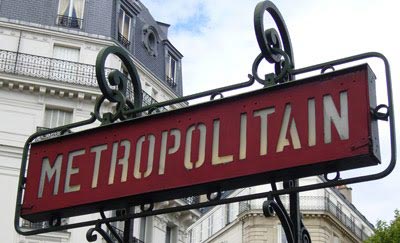
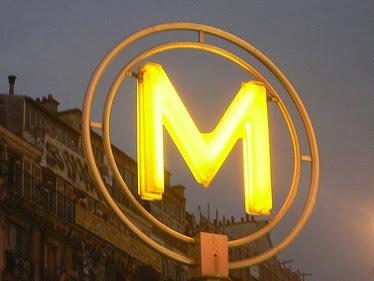
Some Metro stations are joined with large train stations (“gare”) serving other types rail transport such as intercity surface trains and RER regional express trains which travel both above and below ground. Some notable large stations within Paris serving all three types of train transport include: Gare St. Lazare, Gare du Nord , Gare de l’Est, Gare de Lyon, Gare d’Austerlitz and Gare Montparnasse. Most stations and Paris Metro lines are not handicap accessible save for a few exceptions . Stations have multiple entrances/exits, up to ten for the largest underground station, Chatelet Les Halles.
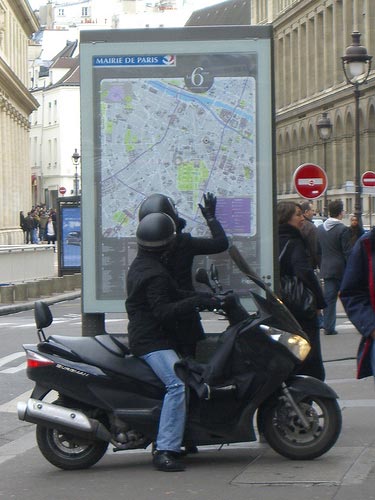
Street maps are posted throughout central Paris providing information on the local district (“arrondissement”). These maps can be useful in locating nearby Metro stations.
How to buy Paris Metro Tickets
This next section shows how to buy tickets for Paris Metro on your mobile phone, at ticket machines, at staffed ticket windows and how to buy Paris Metro tickets online (with a delivery fee).
Buy on Mobile Phone
You can now buy Paris Metro tickets on iPhone from Apple Wallet or from Android/iPhone Paris Transport apps. Please see the linked articles for details.
Buying Paris Metro Tickets at Ticket Machines
Within a Paris Metro station, Paris Metro tickets (but not all pass cards) can always be purchased from automated vending Metro ticket machines. You can buy Paris Metro cards / day / week passes from any Metro station ticket window, but only a few multiday Paris Metro cards can be bought through Paris Metro ticket machines such as the Paris Visite card.
Metro Ticket Machine Payment Methods
Paris Metro ticket machines all accept Euro coins (for purchases up to 30€) and European debit cards (with smart chip) as payment. Visa and Mastercard credit/debit cards are accepted for buying tickets at most Paris Metro ticket machines and ticket windows. American Express / Amex is not accepted for Paris train tickets at vending machines nor ticket windows. Some combined Metro/RER/Transilien ticket machines (one example pictured below) at major train stations (Gare du Nord, Gare de Lyon, etc.) and airports such as CDG Airport train station or Orly Airport, accept Euro coins, Visa & Mastercard credit/debit cards, French and foreign chip debit cards, but Paris Metro station ticket machines inside of central Paris Metro stations usually do not accept cash notes for payment.
Below is a photo of several combined Paris Metro / RER / Transilien ticket machines found at RER train stations, large main-line (Grandes Lignes) train stations like Gare du Nord, and any combined Metro/RER station.
Every Paris Metro/RER ticket vending machine accepts Visa/Mastercard credit cards (not AMEX), Carte Bleu (French debit card), foreign chip-enabled debit cards, and Euro coins (2€, 1€, 0.50, 0.25, 0.10, 0.05 Euro coin denominations). The newest machines accept Visa Mastercard tap to pay option as well, visible as the yellow pad. The blue square pad to the right of the PIN pad is a Navigo reader, used for recharging Navigo cards.
Paris Metro ticket machine Navigo card reader recharge pads are often circular and purple like in the below photo:
See Paris Metro ticket machines for step-by-step details on buying Paris Metro tickets from automated ticket vending machines inside central Paris or combined Metro/RER/Transilien ticket machines for buying Paris transportation tickets/passes from machines found at major Paris train stations and Paris airports.
If you need to use a credit card to buy Paris Metro tickets or Paris Metro pass card and the automated ticket machine doesn’t show a Visa or Mastercard symbol, then visit a ticket window to buy Metro tickets & Metro pass cards where you’ll be able to use a credit card for the purchase.
Buying Paris Metro Tickets at Ticket Windows
You can also buy Paris Metro tickets from personnel staffed ticket windows at any Paris Metro station. Keep in mind that Paris Metro stations often have several entrances and a manned ticket office is usually only open at one of those entrances at any given time. The other Metro station entrances will have ticket machines and fare gates / turnstiles for pass card & ticket holders to enter without human staff nearby to help.
There are several different Paris transit passes / unlimited ride tickets and single-use tickets for Paris Metro, bus, tram or Paris RER and specific tickets for CDG airport and Orly airports by RER or Roissybus / Orlybus as shown on the below fares sheet:
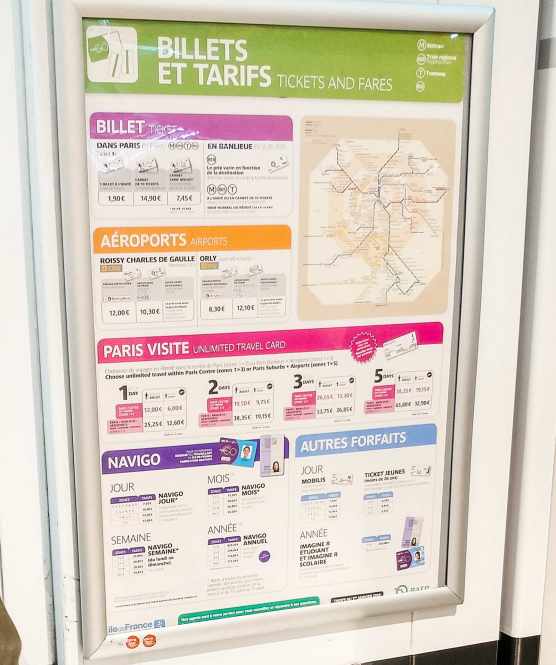
Paris Metro tickets, passes (Navigo / Paris Visite) and other fares posted at Paris Metro ticket window
The basic Paris Metro ticket is the Ticket t+. When buying single Metro tickets you would ask: “Un ticket Metro” [ungh-teekay-mehtro]. This ticket is good for a single ride anywhere on the Paris Metro system, including transfers between Metro lines without zone limitations (or RER lines within Paris Zone 1), within 2 hours of validating the Paris Metro ticket using a turnstile or fare-gate. Paris Metro tickets can be bought one day and used at any time in the future as they are validated / activated upon use (in a turnstile or fare-gate), not upon purchase. See Paris Metro ticket t+ for detailed information on the basic Paris Metro ticket, costs, how to use it, etc.
Buy Paris Metro Tickets Online
You cannot buy single/individual Paris Metro tickets online. You can only purchase a Navigo Easy card pre-loaded with 10 tickets from a 3rd party reseller that must be picked up in-person by you inside Central Paris, not at either Paris airport and it cannot be mailed/couriered/delivered anywhere. To buy a pack of 10 Paris Metro tickets online for in-person pickup (inside central Paris), you can visit the ParisJeTaime.com website.
Please see the note about Can I buy Navigo Easy Online for more information about buying online. (Note: I don’t recommend you do this. Consider using the official Paris transportation mobile phone app for purchasing Paris transport tickets abroad.)
How to Use Paris Metro Tickets & Passes
After buying your Paris Metro ticket, we’ll now show you how to use your ticket or Navigo pass card to get past fare gates, then get to train platforms, opening train car doors, etiquette on boarding, exiting, seating and more, to help you ride the Metro like a Parisien.
This section explains:
- where to go after buying Metro tickets or passes from ticket windows or vending machines
- how to use your Metro fare to pass through gates & turnstiles
- how to get to the right Paris Metro train platform
Ticket Gates
Access to Paris Metro train platforms is controlled via turnstiles or gate type barriers. After buying Paris Metro tickets from ticket windows or ticket machines make your way to the closest fare gates or turnstiles. Below is a photo of typical Paris Metro fare gates which separates public spaces from areas reserved for Metro ticket & Navigo pass card holders.
Recognize Different Fare Gates
Things to note about Paris Metro turnstiles & fare gates pictured above:
- All green/green arrow Paris Metro turnstiles / fare gates accept Navigo pass cards
- Some turnstiles are reserved for exiting the fare-paid area (red with X’s)
- Most Paris Metro fare gates accept both paper tickets & multi-use passes (Navigo, Navigo Easy, mobile phone)
- A few fare gates (left most green one) will only accept Navigo pass cards & mobile phones / smart-watches and no paper coupon-style tickets of any sort.
The key point: choose an appropriate fare gate depending on the Paris Metro ticket or card you are holding.
Navigo-Only Fare Gates
You don’t want to walk up to a Navigo-card-only “reserved” gate holding a paper ticket, which won’t be accepted, while a horde of hurried Parisians wait impatiently behind you to pass through and you are forced to apologize & weave your way back out past them to a line up for a different gate that will accept paper tickets.
Navigo reserved gates often have a sticker on the front indicating that no paper coupon Metro tickets can be used. If you’re using Paris Metro Ticket t+… don’t use these turnstiles / fare gates. There are no slots for inserting paper coupon tickets and only have Navigo pass card readers.
Open/Entry Gates vs. Closed/Exit Gates
Also, don’t walk up to red color fare gates which are open by default, expecting to get past without using your Metro ticket or Navigo card. These red exit gates will slam shut as you approach, preventing you from passing through and you cannot use your pass or ticket to open them. They are reserved for exiting passengers only.
Most Paris Metro fare gates will have a ticket slot on the front, some with a green arrow pointing towards it, indicating this fare gate is open and ready to accept magnetic stripe coupon-style tickets such as Paris Metro Ticket t+, Paris Visite, RER tickets, etc. Underneath the green arrow can be a sticker reading: NaviGO, showing that this turnstile also accepts Navigo pass cards, which are used by holding the Navigo card on the top of the ticket slot device, where a large purple circular reading pad is located (see image further below).
Inserting Tickets into Gates
To operate a Paris Metro fare gate barrier or turnstile such as the ones pictured above with a Paris Metro ticket, insert the ticket magnetic stripe side down, into the barrier’s ticket slot. The ticket slot should be on your righthand side while inserting the ticket. If you find yourself inserting a ticket on your left, you’re opening the next gate over to your left, not the one you’re currently standing in.
Upon inserting your Paris Metro ticket, it will be read, stamped (with a validation code) and then ejected at the top of the machine where you need to retrieve your ticket to open the gate / unlock the turnstile.
Collect Your Ticket to Pass
If the ticket is accepted, a short high pitched buzzing sound will be emitted, sometimes along with a message displayed on the turnstile requesting you take your ticket back (“Reprenez votre ticket”). Remove the ticket and walk through the turnstile or approach near the gate barrier and wait for it to open. Some gates are slow to open, especially double door gates which slide/retract outwards to let you pass. If your ticket appears to have been accepted, yet the gate has not swung open, be sure you have retaken your ticket from the top of the machine and that you’re standing near enough to the gates in order to trip the visual sensor. Be patient and don’t panic. The gate should swing open within 5 seconds maximum. A ticket that is not accepted will cause the turnstile to emit a longer, lower pitched (unpleasant) buzzing noise, sometimes with a message in red indicating your ticket was not valid. Show your ticket to an employee at a ticket window or information booth for help in this case, saying your ticket does not work. They will usually open a wheelchair accessible gate for you to pass through.
Using Barrier Turnstiles
Pictured below is a turnstile barrier gate inside a Paris Metro station with a locking barricade behind the rotating arms of the turnstile to prevent people jumping over the bars. Notice there is no green arrow near the ticket slot (it’s located further below on the front face) nor is there a Navigo sticker on the front (although you will see a large purple Navigo card reader area on top of the machine). After the turnstile has been unlocked/opened with your ticket inserted into the front slot, you will need to retrieve your validated ticket from the top of the barrier machine. Your validated ticket will be located past the purple card reader, where there is a rectangular depression in the metal and a dark area, which has the ticket exit slot and a little mechanical rotating sign that will read: “Reprenez votre ticket” / “Retrieve your ticket”. Collect your validated ticket and walk through the barrier. Be sure to keep your Metro ticket with you until you complete your journey and exit your final destination Metro station. If you are intercepted by a ticket controller without your validated ticket or Navigo pass, you will be fined on the spot for 35€ for having a valid, but non-validated ticket (i.e. a ticket that wasn’t put through a ticket reading machine on the turnstile or fare gate) or 50€ for not producing any valid ticket at all.
Using Navigo Passes
See the Paris Navigo pass article for details on using a Navigo on turnstiles & fare gates.
Find Your Metro Platform
Many Metro stations serve multiple lines through several different train platforms within a single station. To find your way to the correct platform in the correct direction requires that you to keep a mindful eye on signs posted throughout the pedestrian tunnels.
Metro Destination & Station Signs
At each subterranean intersection you will see Metro line numbers and possibly station names which are used to denote direction of travel. Direction of travel is always denoted by the terminus station, the last station or stop on the line, rather than magnetic pole directions such as north, south, east, west. To understand whether the line is going in the direction you wish to travel, you should refer a Paris Metro map, which are posted near station entrances and on all train platforms.
Next Train Signs
Nearly all train platforms have overhead signs showing the time remaining till the next two trains arrive at the station, denoted in minutes. These signs are also a way to verify that you’re on the correct line, heading in the correct direction. The photo below shows Metro Line 4 in direction of Porte d’Orleans with 4 minutes remaining till the next train arrives. On the opposite side of this platform will be another sign of exact same color and number, but the direction will be marked as Porte de Clignancourt, the opposite direction. 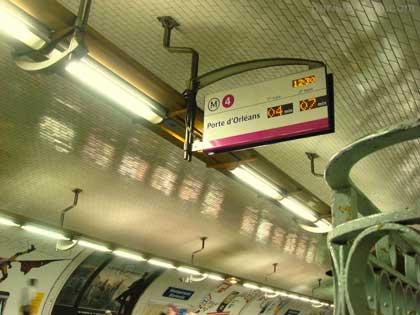 Keep in mind that the train arrival times posted on these signs are only estimates and are not always accurate. Due to traffic congestion and rider issues minutes may be added or subtracted at any moment.
Keep in mind that the train arrival times posted on these signs are only estimates and are not always accurate. Due to traffic congestion and rider issues minutes may be added or subtracted at any moment.
On rare occasion, but worth mentioning, some Metro line platforms are accessed by traversing another platform for a different line. This means you’ll arrive at a platform and think the current platform is the correct one, but in reality, your desired line is further along. Pay special attention to the overhead signs and the system maps posted on the platform walls to ensure you’re on the correct platform.
How to Ride the Paris Metro
Now that you’ve got tickets and passed through Paris Metro turnstiles & gates we’ll show you the physical details on how to ride a Paris Metro train such as opening train car doors, etiquette on boarding, exiting train when arriving at your Metro stop, seating and more, to help you ride the Metro like a Parisien.
Metro train cars come in a variety of different shapes, colors and sizes. Some Paris Metro trains are completely automated, without a driver/conductor, with automatically opening doors and in some stations, gates on the train station platform which close and open in sync with the Metro train car doors.
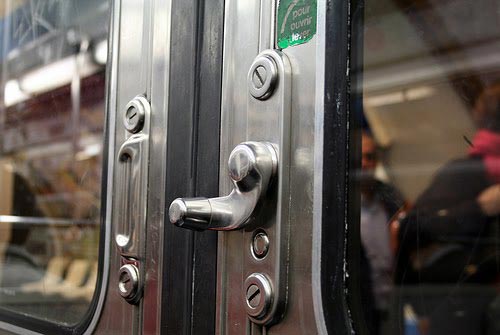
Opening Metro train car Doors
Nearly all Paris Metro train cars require a rider to use a lever or a button to manually open the train car door. If you are the person nearest the Paris Metro car door when the train arrives and there are no passengers exiting, who will open the door as they need to exit before you can enter, you will be expected to open the train car door. This is done through either a lever (older) or a button (newer) on the door itself near the center of the two sliding doors of a Metro car. Metro Line 14 is a notable exception being completely automated and driver-less.
To operate the lever, take hold of the handle that points toward you and rotate the lever upwards to unlatch the train car door. The doors will then slide apart (they are assisted by springs/air pressure) to allow you to enter. On occasion the Metro car doors can be sticky and do not slide open fully to let you enter. In this case a firm pull to the side with your hand on the door itself in the direction it was attempting to travel, will usually suffice to open the train car door the rest of the way.
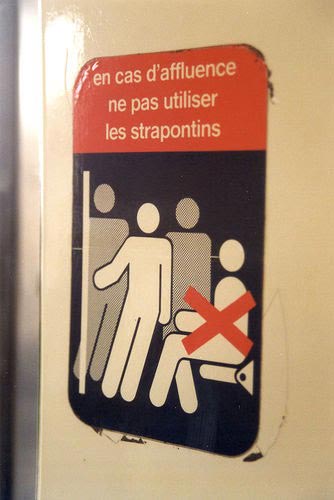
Using Paris Metro Seats
Fold-down seats are available just inside Metro train car doors (called strapontins), but these seats should only be used when there is sufficient space for travelers to easily enter and exit the train car. This means you shouldn’t use these seats during rush hours as generally the Paris Metro will be too busy to use these seats. Instead, stand where the fold-down seats would otherwise be. Rush hour travel on the Paris Metro is a chance to exercise your “personal space” limits. Don’t be surprised if you end up completely pressed up against other passengers. It’s normal and commonplace, happening every rush hour… it’s simply a slice of commuter life in Paris.
During busy hours on the Paris Metro, passengers are expected to move towards the center of the train car in order to make more space for passengers wanting to board the train car. There will be Metro passengers standing in the aisles of the train car holding on to the many hand holds placed at the tops of seatbacks, to vertical poles throughout the train car and poles attached along the ceilings of the train car, some with straps, some without.
Exiting
If you find yourself in the middle of the train car with your stop nearing, try to move closer to the doors during the arrival at the station before your desired stop. This puts you in a better position to exit the train when your Metro stop arrives. At each Paris Metro stop there will be an exchange of passengers getting off the train car and entering the car. When arriving at the station before your desired stop, join the group of passengers moving toward the exit, but stop short of the doors to allow other passengers to pass you to exit (and to enter). You want to be close to the doors for your exit, but not right in front as you would block those who need to exit/enter at this stop. Don’t worry about not being able to descend the train when your stop arrives. Simply say “Excusez-moi” and people will immediately begin making room for you to alight, even if it requires that they descend the train also, just to let you off. Parisiens are very well versed in Metro manners and if you’ve read up to this point… you are now as well.
Exiting a Paris Metro station
After having arrived at your desired station you can make your way out of the station by following the blue “Sortie” signs.

These signs will often be mixed with directional signs for various Metro lines shared by a station. This photo shows the multitude of exits and lines available for both the Metro and the RER at the world’s largest underground station: Chatelet Les Halles.
Each exit is usually referred to by the street or landmark upon which it exits.
Photo carboncopyrocks!
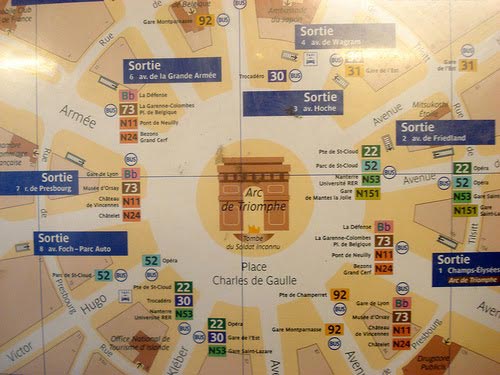
To determine which exit is best for you refer to an exit map located within the Metro station, usually just after exiting the fare paid zone.
To exit the fare paid zone within stations you’ll either pass through exit turnstiles (look for green lights on the face of the turnstiles or for open gates) or through doors opened by pressure plates or infrared sensors.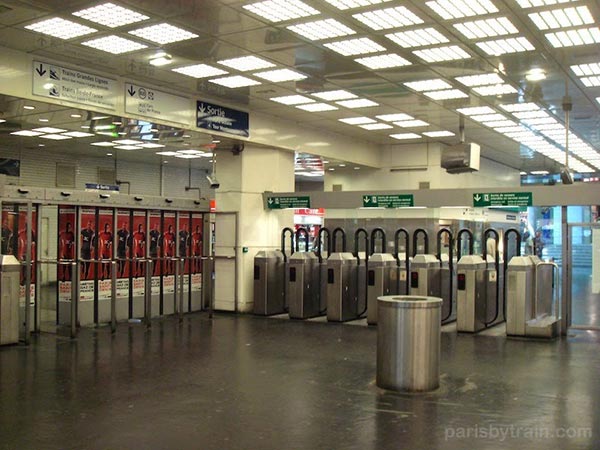
Transfers
(This section refers to transfers included in a single-use Ticket t+. If you’re using a multi-use pass such as Navigo Week/Day pass or Paris Visite, you have unlimited rides during the validity period so you can ignore this section.)
Transfers are allowed on the Paris Metro for up to 1 hour 30 minutes after a ticket’s first validation in a turnstile / fare-gate.
To make a transfer, the two Paris Metro lines must intersect/cross paths; You aren’t allowed to exit a Metro station, walk on the street, enter another Metro station and use your Paris Metro ticket again (except when specifically marked at the exit of a station, noting “correspondances par la voie publique” is allowed. See Allowed Public Street Level Transfers article). Similarly, you can’t use a single Paris Metro ticket for a return trip after arriving at a destination, exiting the station and returning within 1 hour 30 minutes to ride in the opposite direction. This is not allowed.
Transfers from Paris Metro to Paris RER (and vice versa) are permitted as long as the RER station is inside Zone 1.
Transfers from Paris Metro to Paris Bus or Tram using a Ticket t+, is not allowed; You’ll need a new ticket to transfer from Paris Metro to Bus or Tram.
Also the Funiculaire de Montmartre doesn’t allow any transfers onto it or off of it. Once a ticket is used for the Funiculaire, it is spent and unusable for any other trip.
Frequently Asked Questions
Difference between Paris Metro and RER?
The Metro is a classic subway system: mostly underground, many stops, frequent service, short line distances, serving the urban city centre, non-scheduled train timings. The Paris RER (Réseau Express Régional) is a commuter train system that covers much of the greater metropolitan area of Paris (Ile-de-France ), much further out than that covered by the Metro, including specifically both Paris Airports: Paris Roissy-Charles de Gaulle (CDG) and Paris-Orly (ORY) , Disneyland® Paris, and Chateau Versailles. The confusing part is that the RER traverses central Paris with a handful of stations, acting like an express Metro system with fewer stops, larger trains and faster movement. Paris fare zones apply to the RER train system, unlike the Metro and there are five of them. Using a Paris Metro ticket, the Ticket t+, is permitted on the RER, but only to the limits of Zone 1, the true center of Paris, bordered by the ring road surrounding it, the Boulevard Periphérique.
What’s the best ticket to buy?
If you arrive Monday to Thursday, Navigo Découverte week pass is nearly always your best option. If you arrive Friday to Sunday Navigo Day Pass, Navigo day pass, Paris Visite tickets are other options to consider. More info on choosing a Paris Metro pass and choosing what tickets to buy.
Have a question? Ask here and I’ll answer it. Commonly asked questions will be reposted here.
Further Reading
Guides on Paris Airport trains, Paris Disneyland train and Paris train stations
History, facts and figures of the Paris Metro (wikipedia, en français )
Paris Regional Transport Authority, RATP (partial site available in in English )
References
- STIF: Les Chiffes, 2005. “Le Reseau du Transports en Commun”. http://www.stif-idf.fr
- Extension of M14 & M13 lines in 2007 & 2008 has added 3 new stations, now totalling 300. http://extension-reseau.ratp.fr
What Next?
- Search:
- Ask a question
